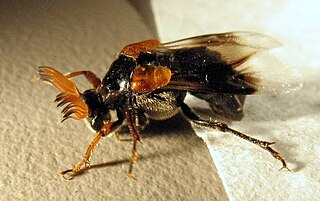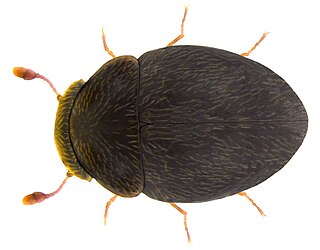
Myxophaga is the second-smallest suborder of the Coleoptera after Archostemata, consisting of roughly 65 species of small to minute beetles in four families. The members of this suborder are aquatic and semiaquatic, and feed on algae.

Prostomidae is a family of beetles with no vernacular common name, though recent authors have coined the name jugular-horned beetles. They are often found in dead wood. The family consist of two extant genera with about 20 species. Prostomis americanus is known from North America. Other species of Prostomis are found in Europe, Africa, the Pacific region and East Asia. Species of Dryocora are known from New Zealand, Australia and Tasmania.

The family Oedemeridae is a cosmopolitan group of beetles commonly known as false blister beetles, though some recent authors have coined the name pollen-feeding beetles. There are some 100 genera and 1,500 species in the family, mostly associated with rotting wood as larvae, though adults are quite common on flowers. The family was erected by Pierre André Latreille in 1810.

Ripiphoridae is a cosmopolitan family of some 450 described species of beetles sometimes called "wedge-shaped beetles". Ripiphoridae are unusual among beetle families in that many species are hypermetamorphic parasitoids, an attribute that they share with the Meloidae. Members of the family differ in their choice of hosts, but most attack various species of bees or wasps, while some others attack cockroaches or beetles. Many species of Ripiphoridae have abbreviated elytra, and flabellate or pectinate antennae.

Scirtoidea is a superfamily of beetles. It is traditionally considered to consist of four families: Clambidae, Decliniidae, Eucinetidae and Scirtidae. However, genetic studies have suggested that Clambidae and Eucinetidae belong to a separate superfamily Clamboidea, which also includes Derodontidae. Scirtoidea and Clamboidea are the two earliest diverging lineages of living polyphagans.

Lepicerus is a genus of myxophagan beetles containing three described species in the family Lepiceridae; it is the only extant genus in the family, with another genus, Lepiceratus only known from fossils. Extant species occur in the Neotropics, from Mexico south to Venezuela and Ecuador. Fossils referrable to the genus are known from the early Late Cretaceous of Southeast Asia.

Jacobsoniidae are a family of tiny beetles belonging to Staphylinoidea. The larvae and adults live under bark, in plant litter, fungi, bat guano and rotten wood. There are around 28 described species in three genera:

Nosodendridae is a family of beetles, with less than a hundred species in three extant genera, which are found worldwide. Nosodendron, the largest genus, is found in forests and attracted to yeast generated slime on the wounds of trees, and likely consumes fermented substances as well as fungi and microorganisms. Several additional genera and species are known from the fossil record. Nosodendridae is considered to be an isolated lineage within Polyphaga, being the sister group to the clade containing Staphyliniformia, Bostrichoidea and Cucujiformia.

The Ommatidae are a family of beetles in the suborder Archostemata. The Ommatidae are considered the extant beetle family that has most ancestral characteristics. There are only seven extant species, confined to Australia and South America. However, the geographical distribution was much wider during the Mesozoic spanning across Eurasia and Australia, suggesting that they were widespread on Pangea. So far, over 26 extinct genera containing over 170 species of these beetles have been described. Three extant genera have been assigned to this family: Omma,Tetraphalerus and Beutelius. The family is considered to be a subfamily of Cupedidae by some authors, but have been found to be more closely related to Micromalthidae in molecular phylogenies. A close relationship with Micromalthidae is supported by several morphological characters, including those of the mandibles and male genitalia. Due to their rarity, their ecology is obscure, it is likely that their larvae feed on deadwood.

Boganiidae is a family of beetles, in the superfamily Cucujoidea. Members of the family are found in southern Africa, Australia and New Caledonia. Adults and larvae are pollenivorous, feeding on the pollen of cycads and flowering plants of the families Myrtaceae, Meliaceae, Cunoniaceae and Elaeocarpaceae. Metacucujus and Paracucujus act as pollinators for cycads Encephalartos and Macrozamia respectively. This association with cycads goes back to at least the Mid-Cretaceous, with an extinct form being found with preserved cycad pollen in 99 million year old Burmese amber.

Silvanidae, "silvan flat bark beetles", is a family of beetles in the superfamily Cucujoidea, consisting of 68 described genera and about 500 described species. The family is represented on all continents except Antarctica, and is most diverse at both the generic and species levels in the Old World tropics.

Helotidae is a family of beetles, in the suborder Polyphaga. The family includes about five extant genera, Helota MacLeay, Neohelota Ohta, Afrohelotina Kirejtshuk, Metahelotella Kirejtshuk, and Strophohelota Kirejtshuk. Helotidae are found mainly in the Old World tropics and are absent from Australia and Madagascar. The antennae are clubbed on the final three segments and is retractable within grooves under the head. The wings have reduced venation with just 4 anal veins. Helotids are known to be associated with sap, fruit and flowers, and the larvae of some species are known to bore into wood in order to pupate.

The Brachypsectridae are a family of beetles commonly known as the Texas beetles. There are only two extant genera, Brachypsectra and Asiopsectra. Brachypsectra has a cosmopolitan distribution, mostly in arid regions, while Asiopsectra is found in Central Asia and the Middle East.

Passandridae, the "parasitic flat bark beetles," are a family of beetles notable for being one of the very few beetle families with larvae that are, as far as known, exclusively ectoparasitic on the immature stages of other beetles and Hymenoptera.

Throscidae is a family of elateroid beetles found worldwide with around 150 species in 5 extant genera. The larvae are soil-dwelling, siphoning fluid from mycorrhizae attached to trees. The adults are short-lived, with the adult males being noted for a complex mating dance. Like some other elateroids, they are capable of clicking.

Clambus is a genus of minute beetles in the family Clambidae. There are at least 30 described species in Clambus.
2017 in paleoentomology is a list of new fossil insect taxa that were described during the year 2017, as well as other significant discoveries and events related to paleoentomology that were scheduled to occur during the year.
Burmese amber is fossil resin dating to the early Late Cretaceous Cenomanian age recovered from deposits in the Hukawng Valley of northern Myanmar. It is known for being one of the most diverse Cretaceous age amber paleobiotas, containing rich arthropod fossils, along with uncommon vertebrate fossils and even rare marine inclusions. A mostly complete list of all taxa described up until 2018 can be found in Ross 2018; its supplement Ross 2019b covers most of 2019.
Acalyptomerus asiaticus, is a species of fringe-winged beetle found in India, Sri Lanka, Malaysia and Thailand. It is also introduced to Jamaica.
This list of 2023 in paleoentomology records new fossil insect taxa that are to be described during the year, as well as documents significant paleoentomology discoveries and events which occurred during that year.
















